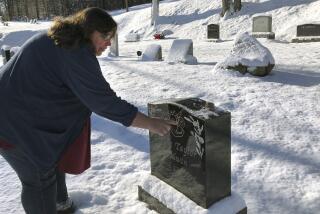Study Reports Decline in Lung Cancer Death Rates
- Share via
Lung cancer death rates appear finally to be dropping among Americans under 45, according to a new study that provides evidence of the effectiveness of anti-smoking campaigns in controlling the country’s most common fatal cancer.
The federal study, published today in the Journal of the National Cancer Institute, found the decline especially striking among white men. But a drop has also occurred among black men and white and black women since the mid-1970s.
“Lung cancer has begun to decline first among white men and younger people because those are the ones who are giving up smoking first,” remarked Dr. Lester Breslow of UCLA. “So this decline among younger men is not surprising. It’s to be expected.”
“Over the years, as younger people quit smoking and don’t smoke as much as their predecessors, we can expect that the cancer mortality rate will begin to clear from the lower ages,” added Breslow, a professor of public health.
The researchers, led by Susan S. Devesa of the National Cancer Institute, predicted in the study that the trend will result in an drop in the lung cancer death rate for all ages, in the 1990s for men and after the year 2000 for women.
“Our . . . analysis suggests that targeting young people for prevention programs has the potential to result in major reductions in incidence and mortality from lung cancer and other smoking-related diseases,” the researchers wrote.
An estimated 142,000 Americans will die of lung cancer this year, according to the American Cancer Society. About 155,000 new cases are diagnosed annually, and only 13% of lung cancer patients live five or more years after diagnosis.
The principal risk factor for lung cancer is smoking.
In the study, the researchers used federal epidemiological data to compare the lung cancer death rates between the mid-1970s and the mid-1980s. They found that the increases were largest among people over age 65 and smaller in the younger age groups.
Most strikingly, they found actual declines in the death rate for men and women of all races studied between ages 35 and 44. The rate dropped 29% among white men, 14% among black men and between 5% and 9% among women.
The actual death rate among white men under 45 dropped from 13.4 deaths per 100,000 men in the mid-1970s to 9.6 deaths per 100,000 in the mid-1980s. The death rate for white men between 45 and 54 also dropped by approximately 7% to 10%.
Rates of lung cancer incidence, as opposed to mortality, followed similar patterns.
William J. Blot, an author of the paper and chief of the biostatistics branch of the National Cancer Institute, said there had been earlier reports of a drop in the lung cancer mortality rate among white men. He said his study was significant in finding that the drop now extends to black men and white and black women.
“It’s encouraging,” Blot said. “It looks as if the decline in the use of cigarettes by Americans is beginning to have an effect and show up in mortality statistics and lower lung cancer rates.”
“Even though it comes as no surprise, I think it’s really good news that we can actually document these changing patterns,” commented Dr. Ronald Ross, a professor of preventive medicine at USC School of Medicine and director of Los Angeles County’s cancer registry.
The cancer institute researchers found that smoking was most common among men born in the 1920s and women born in the 1930s--the groups with the highest lung cancer rates. They found that smoking trends corresponded well with lung cancer trends.
In the 1950s, more whites smoked than blacks. But in recent years, smoking by black men has outstripped that of whites. Black women appear to smoke fewer cigarettes a day than white women. But in both sexes, proportionately more whites than blacks have quit.
Reflecting those trends, lung cancer death rates among black men in general exceeded those for white men in the mid-1980s. Rates were more comparable among women, but black women are still more likely than white women to die of lung cancer.
DROPPING CANCER RATES
Recent changes in average annual lung cancer rates per 100,000 for the age group 35-44: White males: 1973-76: 13.4 1983-86: 9.6: -28.7 White females: 1973-76: 6.6 1983-86: 6.2: -5.3 Black males: 1973-76: 26.9 1983-86: 23.1: -14.2 Black females: 1973-76: 9.0 1983-86: 8.2: -8.9 Source: Journal of the National Cancer Institute






